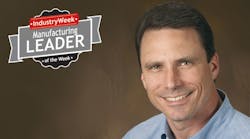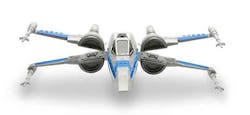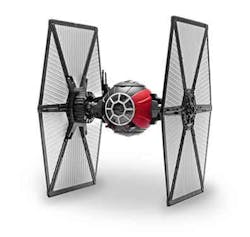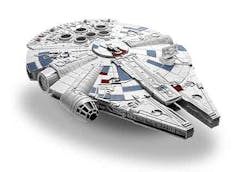Forty years ago, kids who liked to build things knew the snazzy red, blue, and yellow Revell logo. The model-kit maker knocked out plenty of pint-sized Pontiacs and Buicks, but also produced Space Race era rocketships, a “car of tomorrow” called the Lincoln Futura, and a line of musclehead-meets-Sesame Street hot rods with inspired nicknames like “Beatnik Bandit” and “Mother’s Worry.”
But the brand fell onto hard times beginning in the 1980s, as video games increasingly captured boys’ imaginations. Quality dropped and so did visibility on store shelves. By the time Lou Aguilera arrived from Motorola at Revell’s parent company, Hobbico, in 2011, the Revell brand needed some serious Bondo-ing.
“We’re a 70-year-old company, and there’s lots of things we’ve been doing certain ways for a long time, and we are in the middle of changing all of that,” says Aguilera, Hobbico vice president and general manager.
Then in 2014, Revell got the thumbs-up from Lucasfilm, after months of back-and-forth brainstorming, to produce four Star Wars spaceships in anticipation of the Dec. 2015 release of Star Wars VII: The Force Awakens.Aguilera and his colleagues had already been rethinking how to revitalize the company: step up distribution, find ways to streamline the manufacturing. And add a line of models for younger children.
“Kids are getting older younger, and we want to go after a younger segment of the market,” says Aguilera. “”We needed to accommodate the play pattern of a 6-year-old. That meant defining 15 to 20 robust pieces that are easy to handle for small hands.”
The Star Wars opportunity crystallized that plan. But to get four new Star Wars ships on shelves in time, the company practically had to transport itself to another galaxy, one with 3D printers to keep engineering going round the clock. It had to rustle up a whole new supply chain, squeeze an 18-month timeline into nine months, and sell stores on the product without a prototype to pitch them.
Revell execs also envisioned light, sound and functionality that included working landing gear, wings, and an opening cockpit hatch. And during the whole process, Aguilera and his team had to vet production workers and keep some of the details of the toys under wraps as part of their non-disclosure agreement with Disney.
“You know the phrase ‘Measure twice and cut once?’” says Aguilera. “It applies here. We had to do a lot of upfront planning and strategizing to figure out how we were going to bring this to market in such a short time frame.”
He brought in new engineers and designers, some with model experience. Some, however, came from the toy world because the developmental skills of the 6- 8-year-old crowd required models with bigger, more durable pieces that were closer to toys. (Revell calls this new product line ‘Duramod.)
The entire team, from design to tooling to manufacturing, was integrated, so people were all seeing and touching the product in the different phases and communicating with each other. “Everyone knew what the targets were—the cost targets, the delivery schedule,” says Aguilera.
CAD to the Rescue
The whole plan may have hit a wall, however, had Lucasfilm not let Revell use the the Computer-Aided Design (CAD) data from the movie props to design the models. The data arrived in January. That right there reduced our design time at least two to three months,” says Aquilera.
Another lifesaver was having 24-hour engineering and design going, in China and the U.S. “As the people in China were working overnight, through 3-D printing technology we could come in the next day and print out to see the work that had been done,” says Aguilera “And make decisions” on how to proceed.
Without a prototype to show clients, “as soon as we had information we were putting it into some kind of presentation to show customers,” says Aguilera. “Even if we didn’t’ have physical samples, we were pulling screen shots of our CAD design. We were putting shots into a 3-D print into a presentation. So they were almost seeing product real-time as we were developing.”
“The use of 3-D printing was huge,” he adds. This is relatively new for us. It cut down the number of test shots we would need when we were doing our tooling. And that saved significant amounts of time.”
The team had designs to show in February, in time for the New York Toy Fair. “There were some customers that understand who we are as a company,” says Aguilera,”and the level of detail we capture in our models, and they could envision the jump that we were making—‘OK, take this design philosophy and add in durability, lights and sound, functionally’—and visually bridge the gap.
The manufacturers were Disney-approved factories in China. “In the tooling phase, we sent our engineers to Asia to see the final test shots,” says Aguilera.” And we were taking those final test shots and overnighting them back to the U.S. for approval from Disney.”
To cut down on production time and cut costs by 15%, the team figured out how to move more of the decoration (painting the plastic parts) into the manufacturing process, using co-injection molding to incorporate different colored plastics in the manufacturing, so the parts didn’t need painting. “That’s something in tooling we hadn’t really done in the past,” says Aguilera.
But they had to turn on warp speed when they learned that the toys needed to be ready for “Force Friday,” a product promotion push, on Sept. 4, not by the end of October as previously expected. To expedite shipping, they doubled up, loading the first batch of models on an ocean container, then sent the second batch by air. The air freight arrived in time for Sept. 4, and the ocean container 2 ½ weeks later, “which was just in time to provide supply for replacements,” says Aguilera. “It’s been like a tidal wave coming from one side of the world to here.”
Aguilera and company were hoping the Star Wars line would put them on the map not just with their usual hobby shops and craft stores but with the Walmarts and Targets of the retail world. And it did—both stores signed on.
So far, according to Aguilera, Millennium Falcons and TIE Fighters are flying off the shelves faster than you can say "Obi Wan Kenobi." Revell is expecting to sell 300,000 to 400,000 of the models, rather than the usual 60,000 for a new product line. “We got a lot of product coming in, and it’s not staying in our warehouses very long,” says a pleased Aguilera, who is gearing up for what he calls the next “tidal wave” of product right before the movie’s release. Force Friday, he says, "was a culmination of a year's worth of work. But it doesn't end there."







